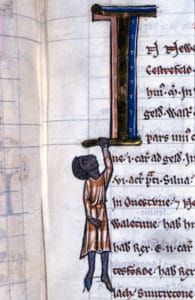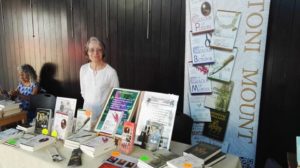 A very warm welcome to Toni Mount, who is visiting us here at the Anne Boleyn Files as part of her book tour for her latest book The Colour of Lies, which is fantastic!
A very warm welcome to Toni Mount, who is visiting us here at the Anne Boleyn Files as part of her book tour for her latest book The Colour of Lies, which is fantastic!
Over to Toni…
In my latest Seb Foxley medieval murder mystery, The Colour of Lies, set in London in the 1470s, readers will meet a new character, Rook. Rook is an African from Abyssinia – modern day Ethiopia. His black skin makes him stand out from the crowd but whilst his presence in London would have been a novelty, was it in any way unique?
Knowing the brilliant Roman historian Mary Beard was told in 2017 that she was talking rubbish when she said there was evidence of black Africans living in Roman Britain, I thought it worth exploring any clues to their presence in England in the medieval period. Incidentally, for the record, aware that the Roman Empire included the entire coast of North Africa and the Red Sea and the authorities’ tendency to enlist foreign auxiliary units and move them to outposts far from home, I would be surprised if no Africans had ever made it to Britannia and, equally, if no Celtic Briton had ever arrived in Carthage.
Before we go in search of scholarly evidence, readers may be interested that in 2007, in the BBC series Doctor Who, the eponymous character, then played by David Tennant, took a trip to Shakespeare’s London in an episode set in 1599. The depiction of the Elizabethan capital included members of the city’s small black population and led to charges of historical inaccuracy. The programme makers were accused of distorting British history in the name of political correctness. So don’t be shocked if there are a few negative responses to this article, or even to my novel The Colour of Lies, although my aim was to produce an intriguing historical tale, not to court controversy.
But what evidence exists for the presence of black people in medieval England?
The skeleton of a female discovered at Fairford in Gloucestershire, England, in 2013 and analysed using forensic anthropological techniques was revealed to be that of a sub-Saharan African woman. Her remains have been dated between the years 896 and 1025 which would mean she lived during the late Anglo-Saxon period, possibly as early as King Alfred the Great’s time or as late as King c***’s.
In 2010, the forensic investigation of a historic skeleton added another black person to the thirteenth-century population of England, this time a male found at Ipswich in Suffolk. The body had been interred in the cemetery of a Franciscan monastery. Stable isotope testing of samples taken from a tooth and a thigh bone and DNA analysis showed that ‘Ipswich Man’, as he was nicknamed, had been born after 1190 and before 1300 in Mediterranean North Africa or southern Spain, where he spent his early life. Skull analysis confirmed that he was possibly Tunisian but had lived in a cold, damp climate for at least the last ten years of his life, so he was not just a casual visitor to England. Before he was aged sixty, he died of a painful disabling abscess on his spine.
The Franciscan friars were well regarded as apothecaries and physicians and the other skeletons found in association with this man’s burial were, in a number of cases, also marked by disease. This suggests that the cemetery was attached to the friary infirmary. Patients did not have to be friars to receive treatment in their hospital, but they would have to profess the Christian faith and were probably expected to make at least a token gesture towards paying for their care. Ipswich Man’s only hope would have been some means of pain relief in his last days and the use of medicinal herbal analgesics was quite sophisticated in medieval England . The friars would have nursed him and prepared his soul for death after which they had papal permission to bury patients from their infirmary in their own graveyard. Nine other African skeletons have been found in the same cemetery and these seem to have travelled even farther than from Tunisia, seeing to have their origins in sub-Saharan Africa.
But how did this man from Tunisia come to be living in eastern England?
One possibility is that he could have been a prisoner taken during the Ninth Crusade in 1270-1271. Robert, Baron Tiptoft, the founder of Ipswich Friary, accompanied the Lord Edward – son of King Henry III who became Edward I in 1272 whilst travelling back from the Holy Land – on that crusade. The English contingent had first landed in Tunis to support the French King Louis IX. Louis was noted for his enthusiasm in the conversion of Muslims to Christianity and it is possible that, as just such a Christian convert, Ipswich Man voluntarily accompanied Tiptoft back to England. A chronicle kept by the monks of St Albans Abbey, Hertfordshire, known as the Flores Historiarium, records four ‘Saracen’ (a catch-all term for Muslims) prisoners who travelled to England after the crusade in 1272 with Thomas de Clare, an associate of Tiptoft. We don’t know what happened to them. They may have languished in prison or worked as servants, or de Clare may have taken them to his estates in Ireland. Or maybe, like Ipswich Man, they could have converted to Christianity and become integrated into the local population.
This brief entry in the Flores Historiarium is just one of a few intriguing literary references to black people in England. Dated to the thirteenth century, contemporary with the events above, is the legendary tale of Moriaen, a romance in the cycle of King Arthur and the Knights of the Round Table. King Edward I had a great interest in Arthur and commissioned the construction of the Round Table that can still be seen in the Great Hall of Winchester Castle in Hampshire, England. In the story, Moriaen, son of Aglovale, is described thus: “He was all black, even as I tell ye: his head, his body, and his hands were all black, saving only his teeth.”
Also from the thirteenth century (c.1241), we have an intriguing illustration from a copy of the Domesday Book of a black man clinging to the initial letter ‘I’ (see below).The Domesday Abbreviato, also known as the Exchequer Abbreviato in The National Archives, is one of three abbreviated versions of the Domesday Book produced in the thirteenth century. The original Domesday survey of England was ordered by William the Conqueror in 1085, to find out who owned what land and resources so that the king could levy taxes and make certain he received his dues. The survey covered thirty-seven counties and named 13,418 places, giving the names of landholders, the manors each landholder owned, their values and the names of their tenants, the names of many boroughs and details of their customs. It also included the number of freemen and others in each manor and the resources available, including taxable land uses, how many plough teams, livestock, water-mills (windmills were a later invention), equipment and buildings.
The format of the Domesday Book wasn’t easy to update and details were often buried in the text, making essential information about landholding, manors and titles – so important for levying taxes – difficult to find. These key details were extracted into summarised versions like the Exchequer Abbreviato which were more portable and contained the essential information needed for immediate administrative use. The Abbreviato is sumptuously illustrated – a document fit for a king. The initial capitals of each county are picked out and illuminated in gold, red and blue with illustrations of the king, archbishops, bishops, barons, earls, many mythical beasts and, in this unique instance: a black African.
The entry for each county opens with ‘TERRA REGIS’, ‘the king’s land’, with its capital letter beautifully painted. The size, colouring and detail of the initial indicates the importance of the landholder whose property is then summarised. The capitals for the king’s holdings include gold and are always the largest, most colourful and ornate. The capitals for other entries are more modest in red and blue. The capital letter for the entry for Derbyshire has a man of African descent holding onto a letter ‘I’. Its colouring and size indicate that the entry summarises the king’s property in the region. Why might the Abbreviato feature an image of an African man? The scribe for this entry might have seen an African who came as a prisoner or visitor following one of the Crusades and he pictured the person as a peasant or labourer . Personally, I think the figure’s patterned hose and striped garment suggest the African had a higher status than that, perhaps attached to a lord’s retinue or household. A peasant/labourer would have worn only the drabbest clothes.
Whatever its meaning to the scribe, the appearance of this African seems quite significant in English black history as a representation of the black presence in thirteenth century England.
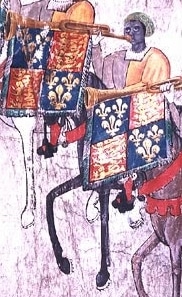 Early in the sixteenth century, Katherine of Aragon may have brought Moorish servants from Africa among her retinue when she came to England to marry King Henry VII’s eldest son, Arthur. A black musician is illustrated among the six trumpeters in the royal retinue of Henry VIII in the Westminster Tournament Roll, an illuminated manuscript dating from 1511. He wears the royal livery and rides on horseback. The man is generally identified as ‘John Blanke the blacke trumpeter’ listed in the payment accounts of both Henry VII and Henry VIII. Also, we know that a group of Africans was at the court of King James IV of Scots at around the same date, including a drummer referred to as the ‘More Taubronar’. Both he and John Blanke were paid wages for their services.
Early in the sixteenth century, Katherine of Aragon may have brought Moorish servants from Africa among her retinue when she came to England to marry King Henry VII’s eldest son, Arthur. A black musician is illustrated among the six trumpeters in the royal retinue of Henry VIII in the Westminster Tournament Roll, an illuminated manuscript dating from 1511. He wears the royal livery and rides on horseback. The man is generally identified as ‘John Blanke the blacke trumpeter’ listed in the payment accounts of both Henry VII and Henry VIII. Also, we know that a group of Africans was at the court of King James IV of Scots at around the same date, including a drummer referred to as the ‘More Taubronar’. Both he and John Blanke were paid wages for their services.
As trade routes were established between London and West Africa, people from this area began arriving in Britain on board merchant ships and would become a more familiar sight. For example, in 1555, the merchant, John Lok, brought several men to London from Guinea. In the account of this voyage, written by Richard Hakluyt, he tells us: “They were tall and strong men, and could wel agree with our meates and drinkes. The colde and moyst aire doth somewhat offend them.”
During the later sixteenth century and the first two decades of the seventeenth century, twenty-five people named in the records of the small parish of St. Botolph’s in Aldgate, London are identified as ‘blackamoors’, i.e. ‘black Moors from Morocco’. This was a time of war with Spain and there was an increase in the number of people reaching England from Spanish colonial expeditions in parts of Africa, not necessarily from Morocco. The English freed many of these captives from enslavement on Spanish ships and brought them to London. Some were of mixed-race African and Spanish but their colour would still have led to their identification as ‘blackamoors’.
In my new Sebastian Foxley medieval murder mystery, The Colour of Lies, the black African character Rook comes from Abyssinia – modern day Ethiopia. Abyssinia had had a Christian community since before the religion ever came to Europe and we know there was a significant African presence in medieval Rome in the fifteenth century. From 1402, embassies from Abyssinia were arriving across Europe. By the 1480s, the church of Santo Stefano degli Abissini in Rome was specifically set aside for Ethiopian Christians to use. (One seventeenth-century writer dates this use to as early as the 1160s!). This established a dedicated place of worship for visiting Ethiopians and the growing Ethiopian community in Europe. We don’t know how many came, nor their names and stories but the possibility of one black African visiting London in 1479 is a likely scenario. He would have stood out from the crowd but, even at that date, his presence may have caused a few raised eyebrows but no more than that. For Rook, though, a difficulty does arise when a scapegoat is required, in which case, any stranger to London is in danger…
Find out more about The Colour of Lies at http://getbook.at/colour_of_lies
To celebrate the launch of The Colour of Lies, MadeGlobal has set up a competition. One lucky person will win seven mugs, one for each of the Seb Foxley medieval murder mystery books. You can enter below by answering the question and filling in your details. All emails and details will be kept private.
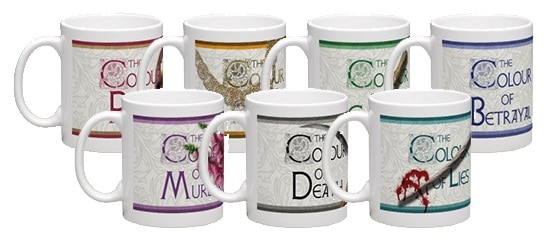
The Colour of Lies
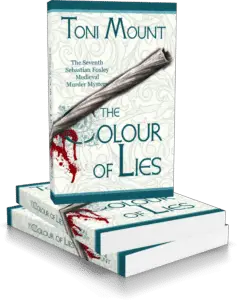 It is late summer and London is all a-bustle for St Bartholomew’s Fayre, with merchants arriving from faraway lands. When an old friend returns with fabulous items for sale, it can only mean one thing: trouble. As thievery, revenge and murder stalk the fayre, Sebastian Foxley – artist and sometime-sleuth – has mysteries to solve. In uncovering the answers, he becomes enmeshed in a web of lies and falsehoods. His greatest dilemma means having to choose between upholding honour and justice or saving those dearest to him. How can a truly honest citizen of London practise deceit and yet live with his conscience?
It is late summer and London is all a-bustle for St Bartholomew’s Fayre, with merchants arriving from faraway lands. When an old friend returns with fabulous items for sale, it can only mean one thing: trouble. As thievery, revenge and murder stalk the fayre, Sebastian Foxley – artist and sometime-sleuth – has mysteries to solve. In uncovering the answers, he becomes enmeshed in a web of lies and falsehoods. His greatest dilemma means having to choose between upholding honour and justice or saving those dearest to him. How can a truly honest citizen of London practise deceit and yet live with his conscience?
The seventh Sebastian Foxley medieval murder mystery from bestselling author Toni Mount takes us deep into a dark world once again.
About Toni
Toni is a history teacher, a writer, and an experienced public speaker – and describes herself as an enthusiastic life-long-learner; she is a member of the Richard III Society Research Committee and a library volunteer, where she leads the creative writing group.
Toni attended Gravesend Grammar School and originally studied chemistry at college. She worked as a scientist in the pharmaceutical industry before stopping work to have her family. Inspired by Sharon Kay Penman’s Sunne in Splendour Toni decided she too wanted to write a Richard III novel, which she did, but back in the 1980s was told there was no market for more historic novels and it remains unpublished.
Having enjoyed history as a child, she joined an adult history class and ultimately started teaching classes herself. Her BA (with First-class Honours), her Diploma in Literature and Creative Writing and Diploma in European Humanities are from the Open University. Toni’s Certificate in Education (in Post-Compulsory Education and Training) is from the University of Greenwich. She earned her Masters degree from the University of Kent in 2009 by the study of a medieval medical manuscript at the Wellcome Library.
After submitting an idea for her first book, about the lives of ordinary people in the middle-ages, Everyday Life in Medieval London was published in 2014 by Amberley Publishing – the first print run sold out quickly and it was voted ‘Best history book of the year’ at Christmas 2014 on Goodreads.com. The Medieval Housewife was published in November 2014 and Dragon’s Blood & Willow Bark, the mysteries of medieval medicine (later renamed in paperback as Medieval Medicine its mysteries and science) was first released in May 2015. A Year in The life of Medieval England, a diary of everyday incidents through an entire year, was published in 2016.
Having taught history to adults MadeGlobal recruited her to create a range of online history courses for medievalcourses.com, but she still wanted to write a medieval novel: The Colour of Poison the first Sebastian Foxley murder mystery was the result, published by MadeGlobal in 2016. Shortly before publication, Tim at MadeGlobal asked if this was going to be a series – although nothing else was planned, Toni said “yes” and now The Colour of Lies (published in April 2019) is the seventh book in that series.
Toni is married with two grown-up children and lives with her husband in Kent, England. When she is not writing, teaching or speaking to history groups – or volunteering – she reads endlessly, with several books on the go at any one time. She is currently working on The Colour of Shadows the next Sebastian Foxley murder mystery and The World of Isaac Newton, her next non-fiction.
Her websites include:
www.ToniMount.com
www.SebastianFoxley.com
www.ToniTalks.co.uk
You can follow Toni on social media at:
www.facebook.com/toni.mount.10
www.facebook.com/sebfoxley/www.facebook.com/medievalengland/
www.twitter.com/tonihistorian
Images: Illuminated capital letter ‘I’ taken from the Domesday Abbreviatio entry for Derbyshire, possibly c.1241; Catalogue reference: E 36/284, National Archives; Image from the Westminster Tournament Roll showing John Blanke.
